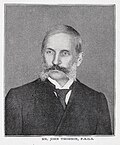English: John Thomson: THE theory of music was understood by the Chinese at a very early period. It is recorded in their ancient Classics, 1 that 2000 years B.C. they used six tubes to produce the sharp notes, and six for producing the fiat ones in the scale. These tubes were originally made out of reeds or bamboo. Subsequently, when they became the standard measures of the notes, they constructed them of some kind of gem. 3 These tubes, which seem to embody the first idea of the organ pipes, became in time the standards of lineal measure, as well as of sound. I have lately seen in China a small organ, said to be ancient, and in some respects resembling the description of the tubes which Dr. Legge has supplied. It has a small mouthpiece, and a series of orifices on the pipes for producing the different notes. The Laos people in the north of Siam construct a simple organ of reeds at the present day.
The Chinese have a number of plaintive and pleasing airs which they sing or perform on their string and wind instruments. They do not, however, appear to understand the principles of harmony, as a band of musicians either play in unison or produce discord ; a strife seeming to exist among the respective players as to who will get through the greatest number of notes in the shortest period of time. Bands of music are hired to dispel malignant spirits and other evil influences, and with. I should think, decided success if these spirits are endowed with musical taste, and appreciate the harmony of sound that, in the tragedy of " Macbeth," appears to have afforded Hecate and her dark sisters a fiendish delight.
" And now about the cauldron sing Like elves and furies in a ring, Enchanting all that you put in I"
The two illustrations represent the Chinese violin and guitar, with the performers, who are hired on festive occasions.


